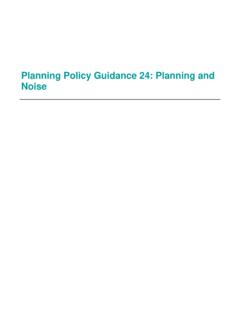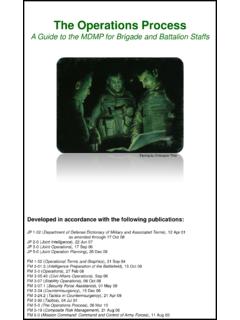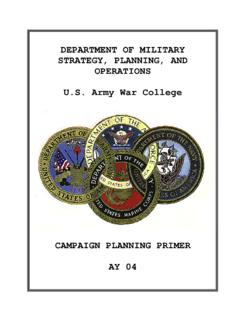Transcription of Guidelines for Programme Design, Monitoring and …
1 Guidelines for Programme Design, Monitoring and evaluation Table of contents KEY TERMS 1. BASIC PRINCIPLES Development cooperation as part of foreign policy Increasing coordination and coherence Strategic planning sets the framework Cooperation has various forms Policies require action Finland as a partner Towards a common language An integrated approach improves learning Project cycle - the life of a development intervention Level of participation varies 1. 3. Achieving sustainable development Policies must match Better value for money Institutional capacity makes a difference People-centered development emphasises socio-cultural aspects Participation enhances ownership Gender equality and participatory development Environment - not only ecology Technology must meet the needs 2.
2 PROJECT DESIGN 2. Situation analysis - the cornerstone of project planning Background studies and the analysis of stakeholders Problem analysis - key to the project s framework Objectives reflect an ideal future Strategic choices begin by fixing the project purpose planning with logic Logical framework is a practical tool Intervention logic states the strategy Assumptions must hold Indicators make the plan concrete Approach describes how Organisation determines roles and responsibilities Budget details financial framework Various roles of the project document 3. Monitoring How stakeholders monitor Integrated approach facilitates Monitoring What is monitored and how Progress reports Annual Monitoring Reports Other performance Monitoring Financial reports 4.
3 evaluation What evaluation is evaluation has two main purposes Different types of evaluations and other related assessments Integrated approach and the Logical Framework Issues to be evaluated General evaluation issues and their relation to the logical framework Factors ensuring compatibility and sustainability How to plan and carry out an evaluation Terms of Reference planning of evaluation requires expertise Participation improves quality Demand for local evaluation capacity is increasing evaluation report - the first step What to do with the evaluation report Dissemination of conclusions and recommendations Approval and operationalisation of recommendations ANNEXES Annex I Integrated approach to project cycle management Annex II General format for terms of reference Annex III Project document format Annex IV Intervention profile/performance summary form Annex V Example of project specific management/ Monitoring set-up Annex VI Example of work plan format Annex VII Reporting, Monitoring and evaluation issues Annex VIII Example of an expenditure follow-up table and related graphics Annex IX Evaluointik sitteet ja looginen suunnittelukehikko (in Finnish) Annex X General format for terms of reference for evaluations Annex XI Programme Completion Report Annex XII Programme /Project Fact Sheet Comments and suggestions to.
4 Ministry for Foreign Affairs Department for Development Policy Katajanokanlaituri 3 PL 176, 00161 Helsinki, Finland E-mail: KEY TERMS Activities Action taken or work performed within a project to transform means into results. Assumptions Important conditions for the success of the project that are not within its control, and which are worded as positive conditions. Beneficiaries A limited group among the stakeholders, who will directly or indirectly benefit from the project. Blueprint planning planning undertaken by expatriate or local officials/technical experts alone, resulting in a detailed implementation plan. Collaborative planning planning based on the collaboration of officials/technical experts and the representatives of the key stakeholders. Development intervention All types of planned undertakings with developmental objectives.
5 Indicator The performance standard to be reached to achieve an objective. Integrated project cycle management Method of managing the project cycle, using the logical framework and the same sustainability criteria throughout the cycle. Intervention logic Strategy for achieving the project purpose, consisting of results, activities and means, and contributing to overall objectives. Logical framework Method for analysing and presenting the most important elements of a project and their interrelationships. Means Human resources, materials and other inputs required to carry out planned activities and manage the project. Overall objectives Long-term development goals to which the project makes a contribution. Participatory planning A way of planning where the initiative and leadership is taken by the beneficiaries, and in which external facilitators participate.
6 Precondition Condition that must be fulfilled before a project can start up. Project In these Guidelines , different types of development interventions, which are designed to achieve certain specific objectives within a given budget and organization, and a specific period of time. Project cycle Model of the entire lifespan of a project. Project purpose The reason for or focus of the project, describing the improved situation which the project is expected to achieve. Results Products of the activities that together achieve the project purpose. Not only physical outputs but a start to enjoyment of sustainable benefits. Stakeholders Groups of people, organisations and institutions who have a direct or indirect interest, or a role, in the project, or who affect or are affected by it.
7 Sustainability In the context of a single project, the continuation of its benefits and impact after the project itself has ended. 1. BASIC PRINCIPLES Development cooperation as part of foreign policy Development cooperation is an important part of Finnish foreign policy and external relations. To meet various objectives, Finland uses different multilateral and bilateral channels. Whilst project assistance still holds the dominant position in bilateral cooperation, both sectoral and program assistance are becoming more important. These Guidelines are meant primarily for design, Monitoring and evaluation of projects, but the basic principles are applicable in all types of cooperation. Reduction of poverty, protection of the environment, and promotion of equality, democracy and human rights are the principal goals of Finland s development cooperation.
8 They are an integral part of the planning , implementation, Monitoring and evaluation of all development interventions. Increasing coordination and coherence The strategy of Finland s Development Cooperation in the 1990 s was endorsed by the Government and Parliament in 1993. The justification and motives are stated as follows: "Enormous discrepancies in wealth and well-being between the developed and the developing countries are not acceptable by any human standards and constitute a threat to the prosperity and security of all nations. Through its foreign and economic policies, Finland, together with other developed countries, is doing what it can to reduce and eliminate these discrepancies." As preconditions for cooperation, the strategy requires that Finland s partner countries commit themselves to the reduction of poverty, to combat global threats to the environment and to promote social equality, democracy and human rights as essential elements of sustainable development.
9 The Finnish Government s 1996 Decision in Principle reconfirms these goals as the Guidelines for Finland s development cooperation. External assistance cannot be a substitute for a partner country s own national resources. At its best, external assistance serves as a catalyst for development, to enhance conditions where governments, private sector, communities and individuals take the initiative and lead into their own hands. To strengthen coordination and coherence between development, trade and other policies, the Finnish Government aims for a comprehensive strategy for Finland s relations with developing countries. Membership of the European Union brought new opportunities and challenges to Finnish development cooperation. This document, based on the project cycle management principles of the European Union, is an important step in the coordination of Finnish development cooperation with the EU practice.
10 Strategic planning sets the framework Long-term objectives of Finnish development cooperation are specified in the rolling five-year financial and action plan. Annual budgets approved by Parliament give further guidance and confirm financial commitment authorisations for coming years. Country-specific objectives are elaborated in negotiations with partner countries. When setting priorities, Finland emphasises the primary responsibility of the partner country. Identification of development projects is founded on different forms of communication between partner countries, and is based on mutual negotiations on different levels. The Ministry for Foreign Affairs also prepares strategies for larger geographic areas. Sectoral and thematic Guidelines set policies to that effect. Separate manuals deal with issues relevant to the sustainability.



















